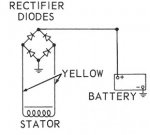What kind of voltage should the alternator on a 1970 60hp johnson put out? I'm not having any issues but I was just curious? My newer boat battery sits at about 12.5 volts normally, when I start the motor it drops like normal and once the engine is running, the voltage reads about 12.35 volts? Is that normal?
Just want to make sure everything is good.
Also, I've posted awhile ago about my lower unit getting water in it. I fished with it all day sunday and cracked open the drain plug to see if any water comes out. I didn't see any water come out and its hard to tell what the Type C fluid look like after its been used a couple times. It's definitely not "milky" but its not clear like it is in the bottle any more? Also, there is a little hole below the fill plug that seems to leave a small oil spot on my driveway. Is this just oil from the gas/exhaust leaking out that hole?
Thanks for the help guys!
Just want to make sure everything is good.
Also, I've posted awhile ago about my lower unit getting water in it. I fished with it all day sunday and cracked open the drain plug to see if any water comes out. I didn't see any water come out and its hard to tell what the Type C fluid look like after its been used a couple times. It's definitely not "milky" but its not clear like it is in the bottle any more? Also, there is a little hole below the fill plug that seems to leave a small oil spot on my driveway. Is this just oil from the gas/exhaust leaking out that hole?
Thanks for the help guys!























